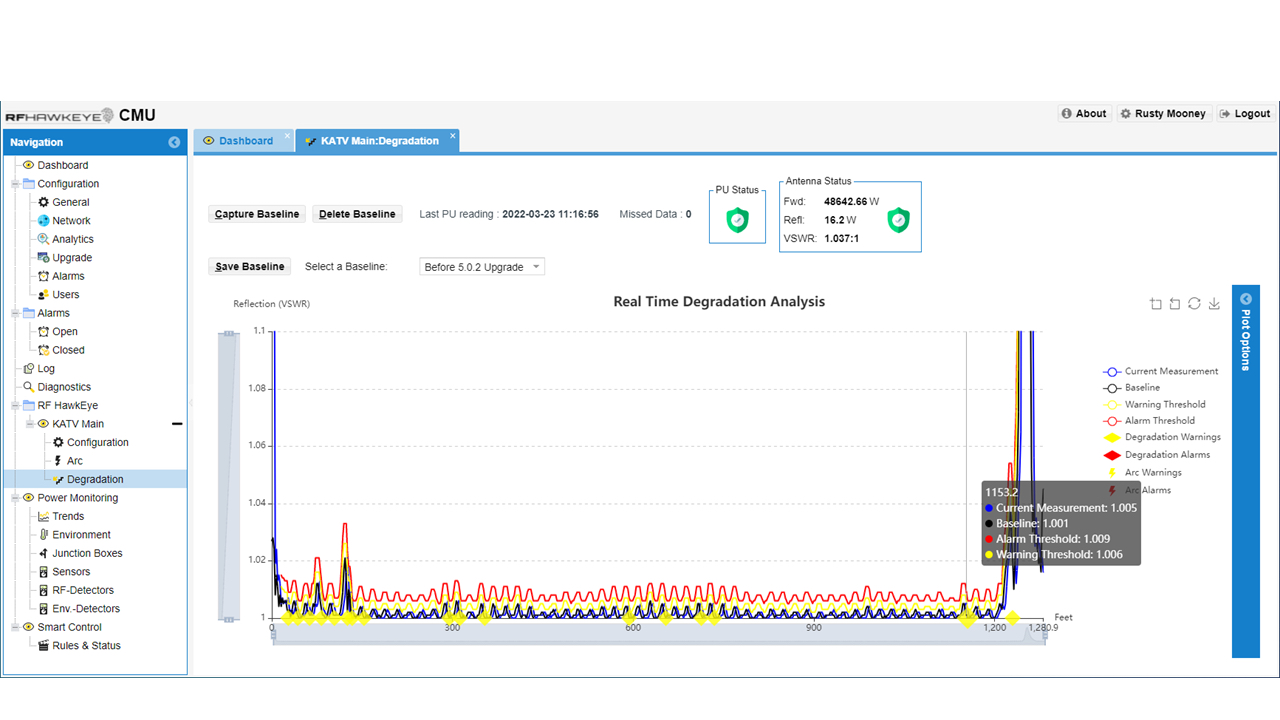
LITTLE ROCK, Ark.—KATV-TV, the Sinclair Broadcast Group-owned ABC affiliate here, has installed a Dielectric RFHAWKEYE system to monitor RF system health beyond the transmitter, the company said today.
The RF monitoring system was installed together with a new transmitter in late 2021 and immediately removed barriers associates with decades-old monitoring procedures that required a degree of guesswork and were time-consuming, the company said.
“We knew that there was potential trouble in the transmission line or the antenna if there was a significant increase in reflected power, but smaller, localized changes were not caught — and often too late to prevent damage,” said Rusty Mooney, SBG manager of transmission system.
The previous system in use monitored only forward and reflected power in the transmitter, he said.
“Our only option was to use a network analyzer to perform a full sweep of the line to identify and locate the problem. That is a very time-consuming process. Not only does it require a rigging crew to climb the tower but the station engineer, or RF consultant, must open very heavy transmission line components. It means working above your head and turning wrenches from a ladder while pulling apart the line. No one enjoys doing that, but it was the only way,” he said.
The real-time, IP-based RFHAWKEYE system discerns small, yet potentially damaging changes in the transmission line while the station is on the air. Due to its continuous time-domain measurements of all post-transmitter RF passive components, the system provides insight into performance trends over time, helping engineers predict and address problems before significant damage and downtime happens, the company said.
RFHAWKEYE enables engineers to understand and pinpoint the exact location of an issue from a computer or cellphone with RFHAWKEYE’s user interface. If the local engineer is not familiar with Time Domain Reflectometry (TDR) measurements, the system can be monitored remotely by a regional or group manager as well as by Dielectric engineers, the company said.
The professional video industry's #1 source for news, trends and product and tech information. Sign up below.
“RFHAWKEYE allows us to monitor line arcs and degradations along with forward and reflected power, which by default helps us understand antenna health,” said Mooney. “If we have high reflected power but there are no arcs or degradations in the line, we know that something is off with the antenna. The ability to prove there aren’t any issues in the line is a huge step forward.”
The station recently used its RFHAWKEYE system to address the aftermath of a direct lightning strike to its tower. The strike took out antenna obstruction lights and a generator while also damaging the generator’s automatic transfer switch. More urgently, a microwave system went down, taking the station off the air.
“We got the microwave up fairly quickly, but then realized that the transmitter had a high amount of reflected power after the lightning strike,” said Mooney. “This was shortly after we installed RFHAWKEYE, so we worked with the Dielectric team to review historical and trending data.”
The review quickly confirmed there was a 1.4 to 1 mismatch with reflected power. “We correlated the time with the transmitter log, and we were able to pinpoint that the strike was where the problem started,” he said.
“At the same time, we were troubleshooting that problem, RFHAWKEYE confirmed that there was nothing wrong with the line, and the problem was in the antenna. There was no need to break the line apart section by section, and no need to calibrate everything and sweep the line. After the antenna repair, the RFHAWKEYE TDR display returned to the original stored baseline. The amount of time we saved on troubleshooting was astounding.”
There are three parts to the RFHAWKEYE system: a coupling unit with directional couplers and probe used at the facility in monitoring line degradation; the system’s signal processing unit; and the central monitoring unit, which reports to the user via the system’s user interface. It is also possible to integrate the system into the transmitter’s interlock system or remote control via SNMP for shutdown once fault conditions occur.
“Every connection where the transmitter line mates is a potential failure point, which is one reason why a full line sweep is so time-consuming,” said Mooney. “Even the most subtle variations in time-domain measurements point to a problem that has likely been occurring for some time. RFHAWKEYE lets us review past data to see when a specific line degradation started. That helps us get in front of a potential burnout that takes the station completely off the air. We can pinpoint the exact area of the problem and point the tower crew to the exact location on the tower they need to climb. That kind of detailed visibility can save the station a ton of money when constrained to a window of maintenance work.”
More information is available on the Dielectric website.
Phil Kurz is a contributing editor to TV Tech. He has written about TV and video technology for more than 30 years and served as editor of three leading industry magazines. He earned a Bachelor of Journalism and a Master’s Degree in Journalism from the University of Missouri-Columbia School of Journalism.

